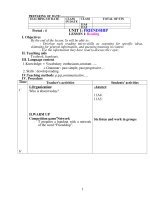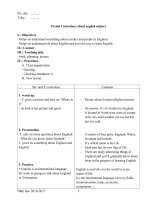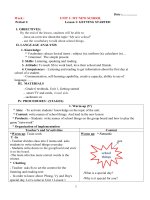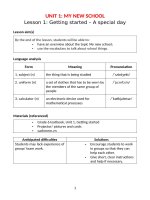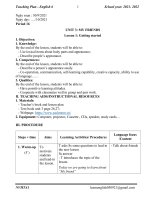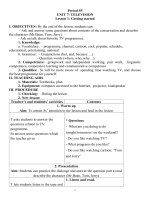Giáo án Tiếng Anh 6 Global success full cả năm chuẩn 5512 đã chỉnh sửa chuẩn 2022 2023
Bạn đang xem bản rút gọn của tài liệu. Xem và tải ngay bản đầy đủ của tài liệu tại đây (12.86 MB, 503 trang )
Date of planning: 3/9/2022
Period 1: INTRODUCTION
I OBJECTIVES :
- Giới thiệu về đặc điểm bộ sách giáo khoa mới cho học sinh .
- Hướng dẫn các phần trong nội dung từng bài của chương trình mới.
- Hướng dẫn phương pháp học cho học sinh.
II PROCEDURES
I Warm up ( 5’)
Chatting :
-Give some question s for ss to answer :
+ How are you today , class?
+ How may students are there in your class ?
+ Who is the monitor?
+ What is your name ?
II Introduce the English book in grade 6 ( 15’)
- Là chương trình tiếng Anh được biên soạn tiếptheo chương trình tiếng Anh
ở bậc tiểu học.
- Quan tâm đến 4 kỹ năng nghe, nói, đọc, viết. Trong đó chú trọng phát triển
2 kỹ năng: nghe, nói. (Kiểm tra thường xuyên chủ yếu dành cho kỹ năng
nói).
- Vào cuối năm học, học sinh cần đạt trình độ tương đương cấp độ A2 của
Khung tham chiếu châu Âu về ngôn ngữ (giai đoạn 1).
- Sách giáo khoa Tiếng Anh 6 được thiết kế với kênh hình và kênh tiếng
phong phú. Mỗi đơn vị bài học được chia thành 7 phần thích hợp cho việc rèn
luyện các kỹ năng nghe, nói, đọc, viết, ngữ pháp, ngữ âm và từ vựng.
- Phần 1: Getting started: Giới thiệu từ vựng và ngữ pháp.
- Phần 2: A closer look 1: Luyện từ vựng và ngữ âm.
- Phần 3: A closer look 2: Học ngữ pháp
- Phần 4: Communication: Thực hành nói tiếng Anh.
- Phần 5: Skills 1: Luyện kỹ năng đọc, nói
- Phần 6: Skills 2: Luyện kỹ năng viết, nghe.
Phần 7: Looking back&Project: Luyện tập, củng cố các kiến thức đã học
III The way how to study English 6 ( 20 ‘ )
1. Tại trường:
- Tập chung nghe giảng, nghiêm túc làm theo các yêu cầu của thầy, cô.
1
- Hăng hái phát biểu ý kiến xây dựng bài.
- Luyện tập nói tiếng Anh với thầy, với bạn bè, tận dụng mọi cơ hội có
thể để tập nói tiếng Anh. Nói đúng trọng âm, ngữ điệu.
- Nắm vững các vấn đề ngữ pháp đã học, các cấu trúc câu. Ghi chép đầy
đủ, chính xác.
2. Tại nhà:
- Ơn lại bài học ngay khi có tiết học ở lớp.
- Dựa vào các cấu trúc và các ngữ liệu đã học để luyện nói tiếng Anh
cùng bạn.
- Làm đầy đủ bài tập trong sách bài tập. Tìm đọc thêm các loại sách
tham khảo nếu có thể.
Thường xuyên học, củng cố và mở rộng vốn từ của mình
III CONSOLIDATION( 5’)
Nhắc nhở học sinh chuẩn bị sách vở đầy đủ cho tiết học
hôm sau
IV HOME WORK
Prepare for the next lesson: Unit 1: Getting started
V.ADJUSTMENT:
…………………………………………………………………………………
……………………………………………………………………………………
……………………………………………………………………………………
.
2
Date of planning:4/9/2022
Period2:UNIT 1: MY NEW SCHOOL
Lesson 1: Getting started – A special day
I. OJECTIVES
By the end of this lesson, students will be able to gain:
1. Knowledge
- An overview about the topic My new school
- Vocabulary to talk about school things
2. Core competence
- Develop communication skills and creativity
- Be collaborative and supportive in pair work and team work
- Actively join in class activities
3. Personal qualities
- Be ready to make new friends at school
- Develop self-study skills
II. MATERIALS
- Grade 6 textbook, Unit 1, Getting started
- Computer connected to the internet
- Projector/ TV/ pictures and cards
- sachmem.vn
III.PROCEDURES
Stage
Stage aim
Warm- - To activate
up
students’
knowledge
on the topic
of the unit.
- To set the
context for
the listening
and reading
part.
- To enhance
students’
skills of
cooperating
with team
mates.
Procedure
* Memorising game:
- Teacher divides class into 2
teams.
- Teacher asks students to close
the books, shows the picture
(pages 6 and 7) and asks them to
memorise every detail in the
picture in 1 minute.
- Teacher hides the pictures and
asks questions about the picture.
The team who has more correct
answers is the winner.
1. How many people can you see
in the picture?
2. Who are they?
3. Where are they?
4. What are the two
students carrying on their
backs?
5. Where are they going to go?
Suggested answers:
3
Interacti
on
Team
work
Time
5 mins
1. I can see three people.
2. They are students.
3. They are at one of the boys’
home.
4. They are carrying school bags/
Presen
tation
(Vocab
–
preteach)
- To provide
students with
vocabulary.
- To help
students wellprepared for
the listening
and reading
tasks.
Practic - To have
e
students get
to know the
topic.
- To have
students get
specific
information of
the text.
backpacks.
5. They are going to go to school.
- Teacher sets the context for the
listening and reading text: Write
the title on the board A special
day. Explain the meaning of
special and ask students to guess
what the conversation might be
about.
VOCABULARY
Teacher introduces the
vocabulary by:
- giving explanations;
- showing the pictures
illustrating the words.
1. subjects (n) [explanations]
2. uniform (n) [picture]
3. calculator (n) [picture]
Task 1: Listen and read.
- Teacher plays the recording
twice.
- Students listen and read.
- Teacher checks students’
prediction.
- Teacher calls 3 students to read
the conversation aloud.
Task 2: Read the
conversation again and tick
(✔) T (True) or F (False).
- Teacher tells students to read
the conversation again and work
independently to find the
answers. Remind students to
underline the information and
correct the false statements.
- Teacher has students pair
compare before checking with
the whole class.
- Teacher calls some students to
4
T-Ss
5 mins
T-Ss
5 mins
7 mins
T-Ss
Ss-Ss
T-Ss
give the answers.
Answer key:
1. T
2. F
3. T
4. T
5. F
- To check
students
understanding
of the
conversation
and help
students use
the words in
context.
Task 3: Write one word from
the box in each gap.
- Teacher has students read the
conversation again, work
independently to put a suitable
word from the box to fill in the
gap.
- Teacher calls one student to
share his/ her answer on the
board.
- Teacher asks students to look at
the board, check their mates’
answers.
Answer key:
1. wear
2. has
3. go
4. uniforms
5. subjects
- To help
students get
Task 4: Match the words with
further
comprehension the school things. Then listen
and repeat.
of the text.
*Pelmanism
- Teacher divides the class into 2
teams.
- Teacher put two sets of cards,
one includes pictures of school
things and the other includes
their names. Members from two
teams take turns and matchs the
names with the correct pictures
as fast as possible. The team
matched faster and correctly is
the winner.
5
S
5 mins
T-Ss
Ss-Ss
T-Ss
Ss-Ss
7
mins
Group
work
6 mins
- To provide
students
vocabulary.
- To check
students’
vocabulary and Task 5: Write names of the
improve group things you can see around the
work skill.
class in your notebook.
- Students work in groups of four
to look around the class and
write down things they can see in
the class.
- Students may ask teacher if
they don’t know the names of the
items.
- Students share with the whole
class.
Wrap- To consolidate Teacher asks students to talk
T-Ss
3 mins
up
what students about what they have learnt in
have learnt in the lesson.
the lesson.
Home To review the - Do exercises in the workbook.
T-Ss
2 mins
work lesson and
- Think of activities students can
prepare for the do at school.
next lesson.
IV.AJUSTMENTS:
………………………………………………………………………………………
………………………………………..........................................................................
..........................................................................................
6
Date of planning:5/9/2022
Period3:UNIT 1: MY NEW SCHOOL
Lesson 2: A closer look 1
I. OBJECTIVES
By the end of this lesson, students will be able to:
1. Knowledge
- Use the lexical items related to the topic My new school;
- Use the combinations: to study, to have, to do, to play + N;
- Pronounce correctly the sounds /ɑː/ and /ʌ/.
2. Core competence
- Be collaborative and supportive in pair work and team work
- Access and consolidate information from a variety of sources
- Actively join in class activities
3. Personal qualities
- Be ready to join some school activities.
- Develop self-study skills
II. MATERIALS
- Grade 6 textbook, Unit 1, A closer look 1
- Computer connected to the internet
- Projector/ TV/ pictures and cards
- sachmem.vn
III.PROCEDURES:
Stage
Stage aim
Warm-up
- To activate
students’ prior
knowledge and
vocabulary related
to the topic.
- To enhance
students’ skills of
cooperating with
team mates.
Procedure
Interaction
Time
* Game: Hot seat
- Teacher divides students
into 2 teams.
Each team has a member
standing against the board.
- Teacher shows pictures of
some activities one by one
and other members use body
language to let their team
member guess the names of
the activities.
- The team with the most
correct answers in the fastest
time is the winner.
Answer key:
Team work
5 mins
play football
7
listen to music
skip rope
drink water
watch TV
Presentation
(Vocab –
pre-teach)
To enrich
students’
vocabulary.
play video games
VOCABULARY
- Teacher introduces the
vocabulary by:
+ providing explanations of
the words;
+ showing picture
illustrating the word.
1. science (n) [picture]
2. exercise (n/v)
8
T-Ss
3 mins
[explanation]
Practice
To teach
students some
activities they can
do at school.
To help student
identify which
nouns go after
which verbs to
make names of
school activities.
To help students
use the
vocabulary in
context.
Task 1: Listen and repeat
the words.
- Teacher asks students to
listen and repeat the words.
- Teacher calls some students
to read the words aloud.
Task 2: Work in pairs. Put
the words in Task 1 in the
correct columns.
- Teacher asks students to
work in pairs and use the
words in Task 1 to put into
the correct columns.
- Students work in pairs and
do the task.
- Teacher calls some pairs to
share their answers with the
whole class.
- Teacher gives feedback and
corrections (if
necessary).
Answer key:
play
football
music
do
homework
exercise
have
school
lunch
lessons
study
English
history
science
- Teacher explains which
nouns go with each verb to
make meaningful names of
activities.
- Teacher asks students to
work in groups of four and
add as many words into each
column as possible.
Task 3: Put the words in the
blanks.
- Teacher asks students to
work independently and put a
suitable word in each blank.
- Teacher allows students to
share their answers before
discussing as a class.
- Teacher asks some students
to share the answers and
gives feedback.
Answer key:
1. homework
9
T-Ss
Pair work
T-Ss
S
Ss-Ss
T-Ss
16 mins
2. football
3. lessons
4. exercise
5. science
Presentation
(Pre-teach
the sounds
/ɑː/ and /ʌ/)
To help students
have concept and
identify the
sounds /ɑː/
and /ʌ/.
Practice
To help students
identify and
practise the /ɑː/
and /ʌ/ sounds.
To help students
practise the
sounds /ɑː/ and /ʌ/
in sentences.
Production
To give students a
chance to
apply what they
have learnt.
PRONUNCIATION
- Teacher introduces 2 sounds
/ɑː/ and /ʌ/ to students and
lets them watch a video about
how to pronounce these two
sounds.
/>ch?v=1F47WdIjn5U
/>ch?v=zUpF0pYoTZ8
- Teacher asks students to
give some words they know
containing these sounds.
Suggested answers:
- /ɑː/: car, start, after, party
- /ʌ/: cut, one, country
- Teacher draws students’
attention to the letters
containing the sounds and
helps them identify the
sounds.
Task 4: Listen and repeat.
Pay attention to the sounds
/ɑː/ and /ʌ/.
- Teacher asks students to
listen and repeat.
- Students work
independently.
5 mins
T- Ss
T-Ss
6 mins
Pair work
Task 5: Listen and repeat.
Underline the words with
the sounds /ɑː/ and /ʌ/.
- Before listening, teacher let
students
discuss in pairs and find the
words with the sounds /ɑː/
and /ʌ/.
- Teacher plays the recording
for students to check and
repeat the sentences.
* Game: Who is faster?
- Teacher divides students
into groups of four, gives
each group a piece of paper,
10
T- Ss
Group work
5 mins
Wrap-up
To consolidate
what students
have learnt in the
lesson.
Homework
To revise what
they have learnt.
asks them to write sentences
including 2 features: school
activities and one of the
sounds /ɑː/ or /ʌ/.
(e.g: I usually play
basketball with my brother.)
- Teacher asks each group to
hand in their paper and
checks, the group with more
correct sentences is the
winner.
- Teacher invites the winner
to read aloud their sentences.
Teacher asks students to talk
about what they have learnt in
the lesson.
- Rewrite the sentences into
notebooks.
- Find 3 more school
activities that have the
sound /ɑː/ or /ʌ/.
T-Ss
3 mins
T-Ss
2 mins
IV. ADJUSTMENT.
……………………………………………………………………………
……………………………………………………………………………
……………………………..
11
Date of planning:8/9/2022
Period4:UNIT 1: MY NEW SCHOOL
Lesson 3: A closer look 2
The present simple
I. OBJECTIVES
By the end of this lesson, students will be able to:
1. Knowledge
- Use the present simple tense
2. Core competence
- Develop communication skills
- Be collaborative and supportive in pair work and team work
- Actively join in class activities
3. Personal qualities
- Exchange personal information with friends and be friendly at school.
- Develop self-study skills
II. MATERIALS
- Grade 6 textbook, Unit 1, A closer look 2
- Computer connected to the internet
- Projector/ TV/ pictures and cards
- sachmem.vn
III.PROCEDURES
Stage
Warm-up
Lead in
Stage aim
Procedure
- To activate * Game: Sentence puzzling
- Teacher divides the class into 4
students’
groups.
prior
- Teacher delivers a set of word cards
knowledge
which are jumbled sentences in present
related to
simple to each group.
the targeted - Students will have to work in groups
grammar of to create as many correct sentences
present
from the word cards as possible.
simple
- The group with the most correct
tense.
sentences will be the winner.
- To increase Suggested sentences:
1.
live near
students’
Peter
s
interest.
his school.
- To enhance 2. We g to
students’
o
skills of
the same school.
cooperating
3.
hav new
with team
They
e
mates.
subjects.
4. We always look
smart in our uniforms.
To introduce
the targeted
grammar of
the present
- Teacher draws students’ attention to
the form of the sentences created in the
game and asks them whether they
know the target tense.
12
Interaction
Time
5 mins
Group work
T-Ss
2 mins
simple
tense.
Presentation
- To have
students get
to know
about the
present
simple
tense.
To help
students
understand
the use of
the present
simple
tense.
1. THE PRESENT SIMPLE TENSE
Task 1: Elicit the present simple
tense.
- Teacher provides or confirms the
answers and leads in the grammar
focus of the lesson:
Positive
S + Vinf/ V(s/es) + … .
Negative
S + don’t/ doesn’t +
Vinf + … .
Interrogative
Do/ Does + S + Vinf
+…?
Answer
Yes, S + do/does.
No, S + don’t/ doesn’t.
W/H questions
W/H + do/does + S +
Vinf + … ?
Notes
Use do/don’t with: I,
you, we, they and
singular noun forms.
Use does/ doesn’t with:
she, he, it and plural
noun forms.
-- Teacher gives students some time to
study the grammar box.
Task 2: Choose the correct answer A,
B or C.
- Teacher has students work
- To check
independently, look at the form and do
students’
Exercise 1 – page 9.
understandin
- Teacher lets students work in pairs
g of the
and exchange the answers before
present
checking with the whole class (explain
simple tense
each sentence if necessary).
Answer key:
1. A
2. C
3. B
4. A
5. C
Task 3: Write the correct form of the
verbs.
To have
- Teacher asks students to work
them use the
independently.
grammar in
13
22 mins
T-Ss
S
Pair work
S
T-Ss
context.
To lead in
and activate
student’s
knowledge
on adverbs
of
frequency.
- To provide
students the
adverbs of
frequency,
and help
them
understand
the
difference in
frequency of
the adverbs.
- To have
the students
use the
adverbs of
frequency in
context.
Practice
To give
students
opportunitie
- Teacher calls 1 or 2 students to write
their answers on the board, checks
their answers sentence by sentence.
Answer key:
1. has
2. Do you have
3. like
4. Does Vy walk
5. ride
6. go
2. ADVERBS OF FREQUENCY
- Teacher asks students to read the
sentences in Exercise 2 - page 9 again
and asks them when to use the present
simple tense, drawing their attention to
the adverbs of frequency.
We often ride our
bicycles to school.
T-Ss
T-Ss
Task 4: Fill the blanks with
sometimes, usually or never.
- Teacher shows the graph and lets
students fill in the blanks with suitable
adverbs of
frequency: sometimes, usually or never
(Exercise 3 – page 10)
Answer key:
2. usually
3. sometimes
5. never
- Teacher lets students work in groups
of four to make 5 sentences using the 5
adverbs of frequency above.
- Teacher calls some groups to read
aloud the answers and gives feedback.
Task 5: Choose the
correct answer A or B to complete
each sentence.
14
4 mins
S
s to use the
present
simple tense
with adverbs
of frequency
correctly in
context.
Production
To help
students
distinguish
and use
correctly the
present
simple
tense.
- To improve
cooperative
skill.
- Teacher has students complete
Exercise 4 – page 10 independently.
- Teacher then asks students to
exchange their textbooks to check their
friends’ answers.
Answer key:
1. B
2. A
3. A
4. B
5.
A
Task 6: Work in pairs. Make
questions then interview your
partner.
- Teacher has students work on the Ex.
5, p. 10 in pairs.
- Teacher checks the answers by
playing a game. Teacher divides
students into 2 teams, 2 students in
each team choose a set of questions
(which are the questions 1-5 in Ex. 5,
p. 10). Teacher may add more
questions if necessary) then interview
each other. The team with higher score
is the winner.
10 points: you/ like/ your new school
20 points:
Question 1: you/ often/ ride your
bicycle/ to school
Question 2: you/ sometimes/ study in
the school library
Question 3: your friends/ always/ go to
school/ with you
Question 4: you/ usually/ do
homework/ after school
30 points: How often/ your mother/
pick you up/ school
Answer key:
1. Do you like your new school?
2. Do you often ride your bicycle to
school?
3. Do you sometimes study in the
school library?
4. Do your friends usually go to school
with you?
5. Do you usually do your homework
after school?
6. How often does your mother pick
you up from school?
15
Ss-Ss
7 mins
Pair work
Team work
Wrap-up
Homework
To
consolidate
what
students
have learnt
in the
lesson.
Teacher asks students to talk about
what they have learnt in the lesson.
To review
Make 5 sentences in the present simple
the
tense,
knowledge
using adverbs of frequency.
that students
have gained
in this
lesson.
T-Ss
3 mins
T-Ss
1 min
IV.ADJUSTMENTS:
……………………………………………………………………………
……………………………………………………………………………
……………………………………..
16
Date of planning:10/9/2022
Period5:UNIT 1: MY NEW SCHOOL
Lesson 4: Communication
I. OBJECTIVES
By the end of this lesson, students will be able to:
1. Knowledge
- Use the lexical items related to the topic My new school
- Know how to introduce someone
- Ask appropriate questions when making friends at school, know what good
qualities a good friend should have
2. Core competence
- Develop creativity and communication skills
- Be collaborative and supportive in pair work and team work
- Actively join in class activities
3. Personal qualities
- Be ready to introduce someone.
- Understand more about good qualities of a good friend and try to be a good friend.
II. MATERIALS
- Grade 6 textbook, Unit 1, Communication
- Computer connected to the internet
- Projector/ TV/ pictures and cards
III.PROCEDURES
Stage
Warm-up
Stage aim
- To introduce the
topic.
- To enhance
students’ skills of
cooperating with
team mates.
Procedure
* Who knows more?
- Teacher divides the class into 2
teams.
- Teacher shows pictures of
some famous pairs of friends
around the world, asks students
to name them.
- The team that gives more
correct names is the winner.
Tom and Jerry
Woody and Buzz
17
Interaction
Time
5 mins
Team work
Lisa and Rose
Spongebob and Patrick
Harry Potter and Hermione
Granger
Leonardo DiCaprio and Tobey
Maguire
Lead-in
To lead in the
targeted
vocabulary and
pronunciation.
Teacher leads students into the
lesson by telling about what they
are going to learn:
Are people above good friends?
Why?
Let’s find out what make a good
friend in our lesson today.
T-Ss
2 mins
* EVERYDAY ENGLISH
Presentation
To prepare
students with
vocabulary.
1. PRE-TEACH
VOCABULARY:
- Teacher introduces the
vocabulary by:
+ giving situation;
+ giving explanation.
1. share (v) [situation]: What
action can you say when you
give your food to poor
children?
18
T-Ss
3 mins
To introduce the
structure of
introducing
someone.
Practice
To practice the
structure of
introducing
someone.
2. classmate (n) [explanation]:
What word can you use to say
about people who are in the
same class with you?
T-Ss
4 mins
2. SENTENCE STRUCTURE:
INTRODUCING SOMEONE
Task 1: Listen and read the
dialogue. (Ex. 1, p. 11)
- Teacher lets students listen and
read the dialogue, asks them what
the characters say when they first
meet someone.
- Teacher calls some students to
share their opinions.
- Teacher gives more explanations
and writes down the structure of
introducing someone.
This is … .
Nice to meet/ see you.
Nice to meet/ see you, too.
Task 2: Work in groups.
Practise introducing a friend to
someone.
- Teacher asks students to work in
groups of four, introducing
themselves to the group members,
using structures above.
- Teacher calls some students to
introduce their new friends to the
whole class.
- Teacher gives feedback and
corrections (if necessary).
5 mins
Group
work
T-Ss
* NEW FRIENDS AT SCHOOL
Practice
Production
To identify
questions people
should ask when
they first meet.
Task 3: Read and tick the
questions you think are suitable
to ask a new friend at school.
- Teacher has students discuss in
groups of four, then asks them to
To identify
add 2 more questions to the list.
qualities of a good - Teacher checks with the whole
friend.
class.
Task 4: Friendship quiz.
Students work independently and
do the quiz in Ex. 4, p. 11.
To apply the
knowledge they
have learnt in this
lesson.
Task 5: Work in groups. Take
turns to interview the others,
use the
questions above.
- Teacher ask students to move to
19
14 mins
Group work
T-Ss
S
8 mins
Group work
places of classmates they haven’t
got acquainted yet, form a new
group and
interview the new mates, then
give feedback on their mates.
- Teacher calls some groups to
make models.
Wrap-up
Homework
To consolidate
what students
have learnt in the
lesson.
Teacher asks students to talk
about what they have learnt in the
lesson.
T-Ss
3 mins
To review what
students have
learnt in the
lesson.
Write down the results and
feedback of the previous
interviews.
T-Ss
1 min
IV.ADJUSTMENTS:
………………………………………………………………………………………
………………………………………………………………………………………
…………………………………………………………………..
20
Date of planning:12/9/2022
Period6:UNIT 1: MY NEW SCHOOL
Lesson 5: Skills 1
I. OBJECTIVES
By the end of this lesson, students will be able to:
1. Knowledge
- Develop reading skill for general and specific information about schools
- Talk about different types of school
- Talk about things they like and don’t like at school and the reasons for that
2. Core competence
- Develop communication skills and creativity
- Be collaborative and supportive in pair work and team work
- Develop presentation skill
- Actively join in class activities
3. Personal qualities
- Understand more about their preference of different types of schools and show their love for the
school.
- Develop self-study skills
II. MATERIALS
- Grade 6 textbook, Unit 1, Skills 1
- Computer connected to the internet
- Projector/ TV/ pictures and cards
- sachmem.vn
III.PROCEDURES
Stage
Warm-up
Stage aim
- To introduce
the topic of
reading.
- To enhance
students’ skills
of cooperating
with team
mates.
Procedure
* Game: Lucky number
- Class is divided into 2 groups.
- Teacher prepares 7 numbers which
includes 5 questions about their
school, and 2 lucky numbers.
- Each team takes turns and chooses
a number and answers the question
behind the number. If the team
answers the question correctly, they
will get 1 point. If the team chooses
the lucky number, they get 1 point
without answering the question and
may choose another number.
Suggested questions:
1. How many classes are there in our
school?
2. Do students have to wear uniform
when they go to school?
3. How many computer rooms does
our school have?
4. Name some clubs in our school.
5. When was our school established?
21
Interacti
on
Time
5 mins
Team
work
PreReading
WhileReading
To lead in the
reading skills.
To develop
reading skill for
general
information.
To provide
students with
some lexical
items before
reading the text.
To develop
reading skill for
specific
information.
Teacher leads students into the lesson
by
showing pictures of 3 schools
Sunrise, An Son and Dream and asks
them some questions:
1. What can you see in these
pictures?
2. Are these schools in the same
place?
3. Which school do you think is in
Viet Nam?
Suggested answers:
1. I can see three different schools.
2. No, they aren’t.
3. The second school.
Task 1: Look at the
picture and quickly read the
passages. Match 1-3 with A-C.
- Teacher asks students to open the
book, read through the text and do
Ex. 1 – p. 12.
- Teacher calls some students to give
the answer, explain which sentence
give them the information.
Answer key:
1. C
2. A
3. B
VOCABULARY
Teacher asks students to get the
meaning of the words boarding
school, international and playground
in
context.
1. boarding school (n) [explanation]
2. playground (n)
[visual]
3. international (adj) [explanation]
Task 2: Read the
passages again and complete the
sentences.
- Teacher asks students to read
through the sentences, predict what
information/ what types of words
they have to fill in the blanks.
- Teacher lets students work
independently and find the correct
answer.
- Teacher lets students pair compare
before checking with the whole
class.
Answer key:
22
T-Ss
T- Ss
T- Ss
T-Ss
S
Pair
work
4 mins
15 mins
1. boarding
2. Sydney
3. mountains and green fields
4. Dream School
5. English-speaking teachers
T-Ss
To identify
different
features of each
school.
PreSpeaking
To help students
form the ideas
for their
speaking.
WhileSpeaking
To help students
use what they
have learnt so
far to talk about
a school.
PostReading
and
Speaking
To help students
improve next
time.
- Check
students’
understanding
about the
reading passage.
- To help some
students
enhance
Task 3: Answer the questions.
- Teacher asks students to read the
questions and underline key words,
reminds them to focus on the types
of information they have to find
(What/ Where/ Which school…).
- Teacher asks students to work in
pairs and find the answer.
- Teacher calls a student to write
his/her answer on the board, then
check sentence by sentence with
class.
Suggested answers:
1. Sunrise is a boarding school.
2. An Son School is in Bac Giang.
3. Yes, there is.
4. They join many interesting clubs.
Task 4: Which school in Exercise 1
would you like to go to? Why/ Why
not? Complete the table.
- Teacher asks students to work
independently and complete the
table.
- Teacher goes around and offers
help if needed.
Task 5: Discuss your choice with
your friends.
- Teacher tells students to work in
groups of four and share the answer,
reminds them to take note the
information from other members.
- Teacher invites some students to
share their preparation and makes
sure they speak in full
sentences.
- Students share their ideas with the
whole class.
- Teacher allows students to give
comments for their friends and vote
for the most interesting and
informative presentation.
- Teacher gives feedback and
comments.
23
Pair
work
T-Ss
T-S
5 mins
Group
work
8 mins
Ss-Ss
3 mins
T-Ss
presentation
skill.
Wrap-up
Homework
To consolidate
what students
have learnt in
the lesson.
Teacher asks students to talk about
what they have learnt in the
lesson.
T-Ss
2 mins
To review the
lesson they have
learnt and
prepare for the
next lesson
Skills 2.
- Teacher asks students to write down
their opinion about a school in their
books.
- Teacher asks students to search for
information about their school.
T-Ss
2 mins
IV. ADJUSTMENTS:
………………………………………………………………………………………
………………………………………………………………………………………
……………………………………………………………………….
24
UNIT 1: MY NEW SCHOOL
Lesson 6: Skills 2
I. Objectives
By the end of this lesson, students will be able to:
1. Knowledge
- Use the lexical items related to the topic My new school
- Listen for specific information about school activities
- Write a passage about their new school
2. Core competence
- Develop communication skills and creativity
- Be collaborative and supportive in pair work and team work
- Actively join in class activities
3. Personal qualities
- Grow more feelings about friends and school
- Be encouraged to attend school activiites.
II. Materials
- Grade 6 textbook, Unit 1, Skills 2
- Computer connected to the internet
- Projector/ TV/ pictures and cards
- sachmem.vn
Anticipated difficulties
1. Students may have
underdeveloped listening skills.
2. Some students will excessively
talk in the class.
Solutions
- Play the recording many times if necessary.
- Encourage students to work in pairs, in groups so that
they can help each other.
- Provide feedback and help if necessary.
- Define expectation in explicit detail.
- Have excessive talking students practise.
- Continue to define expectations in small chunks (before
every activity).
Board Plan
25
